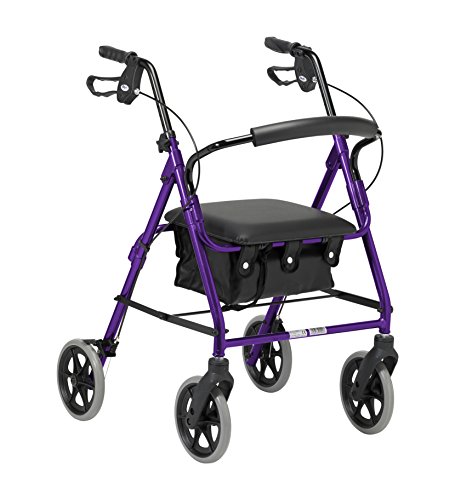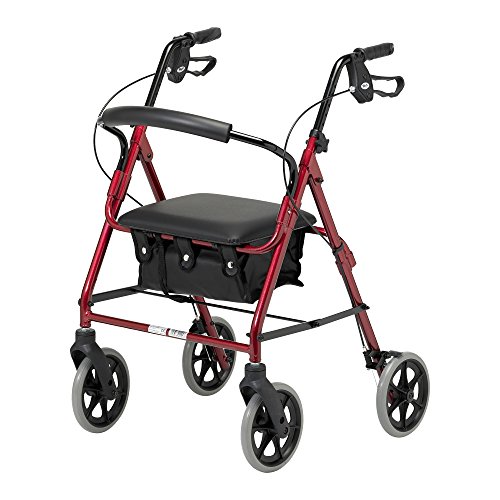5 Must-Know Rollator Folding Techniques To Know For 2023
페이지 정보

본문
 Locking Mechanism For Use With a Foldable Rollator
Locking Mechanism For Use With a Foldable RollatorNearly all rollators come with an element of locking or latch to stop the rollators from being rolled out during storage. This is crucial to avoid the risk of a dangerous situation during transportation.
The lock is usually situated close to the center of the frame. It can be a lever or button. It is important to understand how to make use of this feature.
How to fold a Rollator
Rollators are highly efficient mobility aids for people who require stability and support when walking. They are portable and convenient, and various models are available to meet the needs of different people and budgets. 1 However, some people may be concerned about how to fold and unfold a rollator storage bag in order to make it safe to use.
Luckily, many modern rollators come with simple folding mechanisms. They let users quickly fold their walkers with no need for any tools, making them ideal for storage and transport. The locking mechanism ensures that the stroller doesn't break during storage or transport and provides users with safety and security.
Modern buy rollator with footrest walkers aren't just easy to fold, but they also have ergonomic designs that ensure the safety and comfort of the user. For example, they have comfortable handles, a large basket and a brake lever built-in to prevent accidental activation. In addition they are constructed of lightweight materials to guarantee the ability to move around and are easy to handle.
The traditional rollators weigh more, and they don't support themselves when folded. This makes them difficult to transport or store. The seats are also attached to the frame, so they can't be stored against objects or small spaces. It is essential that those who use rollators know how to fold them for easier storage and transport.
The first step to fold a rollator is to locate the locking mechanism, which is usually located in the middle of the frame of the device. You can lift it gently or let it go by following the instructions of the manufacturer. Once the locking mechanism is removed you can fold your walker by pushing the sides together while holding the releases. Continue to do so until the walker is completely folded and securely locked.
In addition to checking that the lock is securely in place In addition, you must inspect your walker for loose parts and signs of damage or wear. If you spot any issues make sure you repair them immediately to prevent further damage and injuries. It is also recommended to regularly oil all moving parts of the walker to minimize friction and ensure the smooth operation.
The Crossbar
The crossbar is the bar that supports a rollator's frame and wheels. It is typically made of steel and connects the handlebars to the frame's base. The crossbar provides added strength and stability and holds the walker's basket as well as other accessories. Many manufacturers offer a variety of accessories available for their walker models, such as baskets for storage and tote bags. They can be attached to the back or front of the walker, or they could be placed underneath the seat.
A lot of walker models have a crossbar that can be folded in two directions. This makes them easier to store and transport. This is an important feature, especially in the event that the walker will be frequently used for travel or long trips to the supermarket or other places. Some models of walkers come with a removable bag that can be used for additional storage.
Another key characteristic of a rolling machine is the brakes, which are normally placed on the handles or crossbar. There are different types of brakes, such as cable loops and push-down brakes. To stop the walker rolling the user needs to apply downward pressure to the spring-loaded frame. This type of system may not be suitable for smaller users who struggle to engage the brakes, or heavier users who may accidentally activate them.
A cable loop brake system functions more like the brakes on a bicycle. The cable loop brake system can be activated by simultaneously pressing the handlebars in both hands. This type of brake system offers more control and is best for people with weak hand function.
The term "crossbar" is used to refer to one vertical stroke that crosses between two strokes in the form of a letter. The location, length and thickness of a crossbar will affect the readability of any letterform. This is a significant difference between serif and non-serif fonts. The crossbar on the smaller e is commonly referred to as an arm.
The Release Mechanisms
rollators uk play a crucial role in boosting mobility and empowering those who are facing physical challenges. They help distribute the user's weight evenly over their lower body, reducing stress to joints and muscles and allowing easy and comfortable movement. These mobility aids come with features that are customizable, including adjustable handlebars and brakes with built-in seating as well as storage compartments. They allow users to move around with ease and confidence. These lightweight portable mobility aids are covered by Medicare and Medicaid to make them more affordable.
Carbon rollators are easier to transport and store than traditional walkers. They fold in half and can be stored in the trunk. To do this, take the basket from the frame and then pull up the crossbar. This will reveal a pair release mechanisms on each side. After that, press the release mechanisms, and push the sides of the frame until the walking device shrinks to its smallest size.
The locking assembly is attached to a top support arm that is largely horizontal, 218 which connects two front and rear tubular legs that are vertical. Telescoping tubular leg extensions 226 and 228 are releasably attached to the ends of front and rear tubular legs. These telescoping extensions can be rotated between an unlocked and locked position to adjust the height of the rolling aid.
After the extension leg segments are in the correct position the non-sliding handgrip is attached to the end of the lever that is actuated. The housing is attached to the actuating lever via an extension piece that extends away and a recess designed to accommodate the extension piece. The recessed portion and the extension piece provide a fulcrum about which the actuating lever may be pivoted.
Once the leg segments that telescoping are in the proper position, the locking mechanism engages the snap button and biasing spring (not shown). This arrangement allows the user to simply engage or detach the folding mechanisms, allowing for a simple storage and transport of the walking aid.
The Locking Mechanism
 The present invention is the locking mechanism that can be used with an walker or rollator that folds. The invention addresses a requirement to have a lock assembly designed for use with these walkers and rollators that are easy to configure between unfolded and folded positions for those who have limited mobility.
The present invention is the locking mechanism that can be used with an walker or rollator that folds. The invention addresses a requirement to have a lock assembly designed for use with these walkers and rollators that are easy to configure between unfolded and folded positions for those who have limited mobility.Typically, the device that consists of a pair of spaced side frames and the cross brace connecting them includes two handle bars. Two hand brakes have been attached to the handles. Each one has a pin-actuating plunger which engages with a plunger on the respective cross bar. When the user presses the hand brakes, the pin actuating plunger is depressed, thereby causing the side frame to move into a folded position.
One issue that comes with this type of device is that the lever must be held in place by a hand while attempting to depress the plunger that is actuated by the pin. This could be a challenge for people with weak hand strength or dexterity. The present invention addresses this issue by incorporating an assembly for locking that is operationally connected to the lever that actuates.
As illustrated in FIG. As shown in FIG. A lock plate is located inside the bore. It has an opening that can receive the locking end of the locking pin. A portion of the actuating mechanism between the force applying handle end and the body attaching portion is designed to pivot relative to both of the body portions such that the locking pin is moved from a position where it prevents the rotation of the tubular leg to a second position where the telescoping leg extension can be extended.
When the lever that actuates it is moved by the hands of the user the locking pin is moved from the first position to the second. In the process, the leg extension that telescoping is able to be pulled away from the side frame and thereby rotates the latter into a folded position. This can be done with the hand of the user still securely gripping the handgrip 24 of the side frame. This feature can significantly reduce the amount of effort needed to fold a rollator walker for sale in and out of its folded position.
- 이전글All About Online Casinos 24.09.02
- 다음글What's The Current Job Market For Oil Filled Radiators Black Professionals Like? 24.09.02
댓글목록
등록된 댓글이 없습니다.